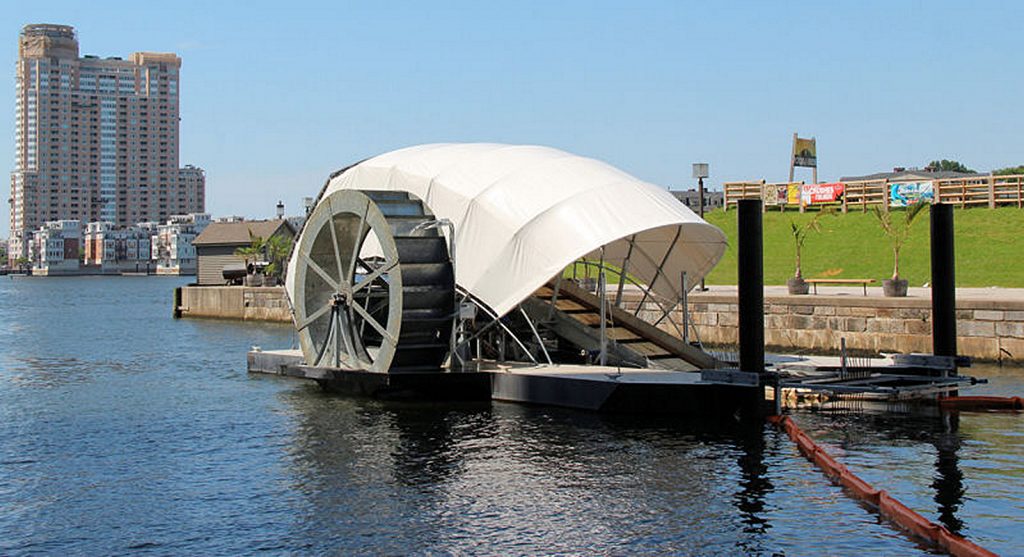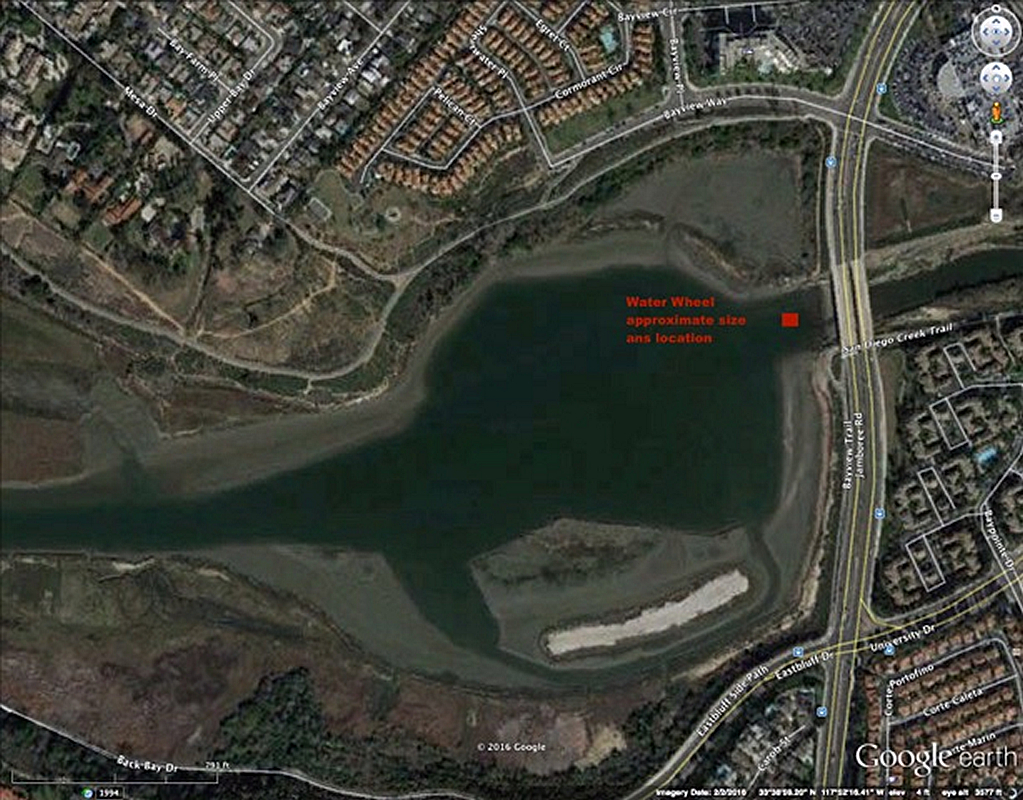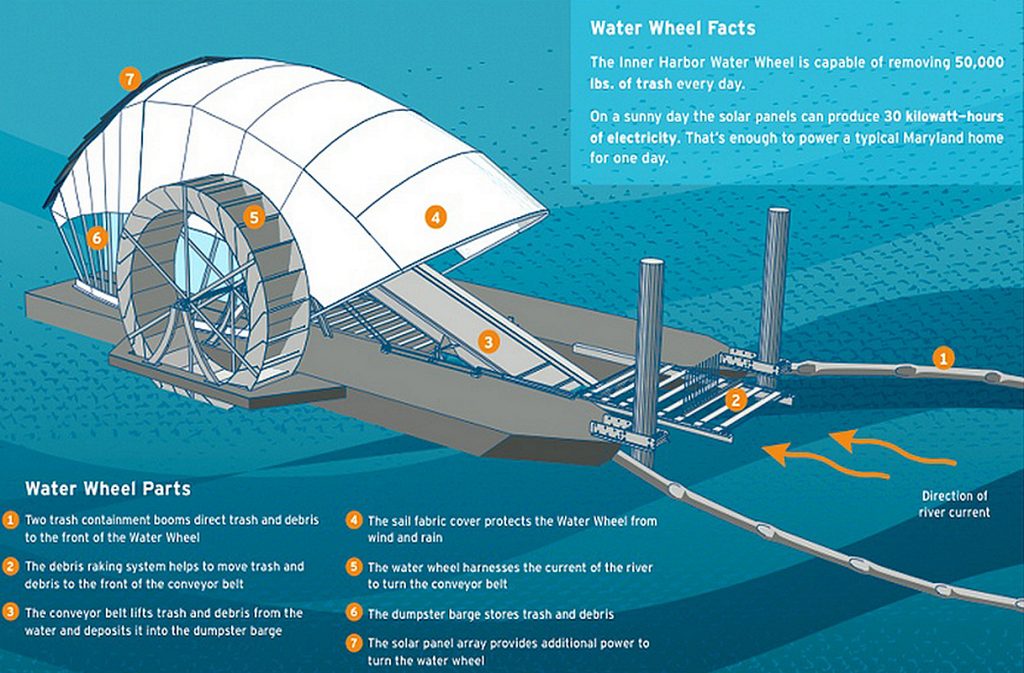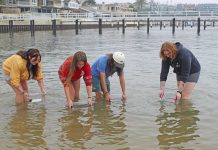
— Photo courtesy of Billy Dutton/Baltimore waterfront ©
In an effort to clean up trash from Newport Bay, the city and concerned residents are considering a variety of solutions, including a proposed solar-powered, debris-gathering water wheel.
The proposed project has been floating around for a few months and the Water Quality/Coastal Tidelands Committee got an update last week.
It is currently going through the California Environmental Quality Act analysis and reporting process, explained Newport Beach Assistant City Engineer Bob Stein.
They are hoping to have the CEQA reports done in time to submit for various grant funding opportunities in the first quarter of 2017, he said.
“It’s not a done deal,” Stein explained, but it does seem reasonable to move forward with the analysis, CEQA process and discussing it with the CA Department of Fish and Wildlife and other pertinent agencies.
“The proposed water wheel concept is an interesting idea to combat the large accumulation of trash that collects in the Back Bay, especially after a storm,” said Mayor Diane Dixon said in an email.
The Committee, which Dixon chairs, is looking at possible solutions and the water wheel is one such solution, she explained. They are “highly concerned about the trash issue (literally tons of trash).”
The Help Your Harbor program collects trash from the bay, mostly via kayak or duffy boats, on the first Saturday of every month. In the last 30 months the group has collected about 10 tons, said Billy Dutton from the HYH program
“We’re just tying to get the trash out of the bay,” said Dutton, who has been helping look into the proposed project.
Other coastal cities have used the water wheel with success, Dixon pointed out. The primary example (and what Newport’s water wheel is based on) is Baltimore, which uses a solar powered water wheel to collect trash from Jones Falls River before it enters the harbor.
Baltimore’s “Mr. Trash Wheel” removed 406 tons of trash from the Jones Fall River between May 2014 and May 2015, Stein reported.
“Based upon the results they are finding in Baltimore, I would expect this to capture over 90 percent of the trash that comes through,” Dutton said. “I would imagine some would still get through, but this should capture most of the trash that comes down the San Diego Creek and enters the Upper Newport Bay.”
The system is basically a stationary, floating barge with a conveyer belt on one end, a standard-sized trash dumpster on the other end, and a water wheel in the middle.
Pylons funnel debris floating in the water toward the conveyer belt. Solar powered water pumps turn the water wheel, which moves the conveyer belt, which carries the trash into the bin on the other end of the barge. The entire thing would be approximately 50 feet long.
It’s “low tech yet high tech” at the same time, Dutton said.

— Photo courtesy of Mark Ward ©
It would be placed approximately 100 feet west from the Jamboree Road bridge in the San Diego Creek, which is the entry point for much of the debris coming into the bay.
The location was chosen by John Kellett, the engineer from Clearwater Mills, LLC, who helped design this solution for Baltimore, and Pat Fuscoe of Fuscoe Engineering, Inc.
When the dumpster is full it’s removed and a new, empty one is put in its place.
It’s proposed that an electric duffy boat would slowly, about three knots, pull the bin through the middle of the channel to shore for disposal.
“We wanted to look for a solution that wouldn’t bring in or introduce any more petroleum toxins or anything like that,” Dutton said.
The physical cost of the water wheel is around $750,000, Dutton explained. They will be applying for numerous grant funds that will also include ongoing maintenance and support, he added.
They are hoping that grant funding will cover the majority of the project, Dutton said. A number of community members have also stepped up to help, he added.
The project first needs to go through the CEQA process before they apply for funding, Stein noted.
There are a multitude of environmental factors that would be taken into account during the CEQA process, as well as aesthetic, biological and community impacts from the project, Hazel McIntosh explained during the April 7 meeting of the Committee.
In the minutes for the April meeting, Tom Houston called the project “righteous” and said it is an opportunity to make a big dent in trash reduction.
But not everybody is on board with the idea.
In April, Committee members discussed noise and visual impact as possible issues.
In an Oct. 23 letter to city Senior Engineer John Kappeler, Newport Bay Conservancy President Peter Bryant had some concerns about the proposed water wheel.
The Conservancy is very concerned with problems of trash accumulation in Upper Newport Bay, the letter notes.
“The position of our board is that we cannot support the proposal of placing a water wheel in the Upper Newport Bay Ecological Reserve,” the Bryant writes. “We feel it would be inappropriate to carry out this kind of construction in the reserve.”
The only construction needed for this project is the insertion of three pylons to keep the water wheel in place, Dutton explained. That “pales in comparison” to the construction for recent large dredging projects.
“It’s going to be very minimal construction for, obviously, great perceived results,” Dutton said.
Bryant also commented in the letter that they felt it would be an “unsightly piece of machinery” and very unpopular with local residents.
Although at a Help Your Harbor informational booth set up on Coastal Cleanup Day, they had positive reactions from people that learned about the water wheel, Dutton reported.
“It’s actually very aesthetically pleasing,” Dutton commented.
However, more residents still are unaware of the proposed project. And it may be obtrusive for some people, Stein noted at the meeting last week.
The Conservancy also questioned the water wheel’s effectiveness in their letter.
“We also argue that it would be quite ineffective, since we understand that it fails during storm events when the trash accumulation peaks, and it is also likely that it will be overloaded by vegetative material coming downstream in large quantities,” Bryant wrote in his letter. “Furthermore, if it were to prove effective, it would require frequent service trips through the reserve to empty the trash collected.”
Dr. Jack Skinner had some of the same questions during the Water Quality/Coastal Tidelands Committee meeting last week.
“Most of the debris I’ve seen come down is during storm events,” Skinner commented. “The question is, when you get that amount of load coming down, is that going to help it?”
How effective will it really be when a large amount of trashed is washed downstream? Skinner questioned.
During the rainy season, the trash gets washed down from inland city streets through the floodways and into the bay.
“In our case it comes through the sensitive Newport Bay,” Dutton said.
The water wheel is meant to stand up against the velocity of a “100-year” storm. Baltimore’s has proven to be resilient, Dutton noted.
Bryant suggested they discuss alternative solutions, different technologies, and other locations.

— Photo courtesy of Billy Dutton/Baltimore waterfront ©
Conservancy officials were enthusiastic to hear about the collection program designed for the Delhi Channel, which Stein said was in progress, but had a long way to go.
Getting something done upstream is the long-term plan, Dixon said at the meeting, but in the meantime this is a viable downstream solution.
“(Ideally), it’s envisioned that eventually an upstream solution will make it so that the water wheel is no longer needed,” Dutton said.
When the water wheel is no longer needed they would remove the pylons and it would be back to the way it was before, Dutton said.
The “fast track” rough timeline estimate would see it installed in about a year or two, but there are a lot of variables.
There are also other benefits to the water wheel, Dutton noted.
It will also collect a lot of the “nuisance vegetation” that travels down the San Diego Creek, he added.
The rotating wheel would put oxygen back into the water, helping enhance the underwater habitat and water quality.
It would inform the public and raise awareness about trash in the bay.
Also, like they currently do in Baltimore, the proposed Newport water wheel would have a webpage explaining it, counting the trash collected and real time video. It could be an educational tool for local students.
It still needs several levels of approval and it is still just a possible “proposed solution” to capturing the trash entering the bay, Dutton emphasized.
They will continue to study the water wheel concept, Dixon confirmed. Committee members directed staff to also consider a bandalog litter trap.
Overall, it’s a “resounding yes,” that it will “absolutely” help the overall health of the bay, Dutton said.
“There are good arguments on both sides of the issue – cost, aesthetics, etc.,” Dixon noted. “Bottom line, we have literally tons of trash floating in the back bay that needs to be continuously collected.”





Round and round you go, to say this will clean up the bay is irresponsible and good intentions with eyes shut. Log booms are in use to collect winter debris from the storm water system that dumps everything into Newports coveted Upper Bay Ecological Reserve, which is a total sham and waisted taxpayer dollars. Like it or not San Diego Creek is a County Storm Water System (Flood Control) and the end of the pipe is the harbor entrance. While floating trash and tree branches liter the bay, it’s the fine microscopic solids (sediments) that carry the evil poisons of urbanization into the bay, that can, and do impair the “protected” biota. Having gone over this problem with many and many times, all City, County and NGO’s take a back seat when it comes time to pay or show why the problem is really there, and step up to spend the big bucks to fix it. Seems like education has been the major star of doing something, bureaucracy just slows things up, and diplomacy is for keeping jobs, positions and retirements plans, plus grants are almost more work than a winning outcome if any. To bad you guys are still 15 years behind really fixing the bay. What ever happened to the Newport Bay Water Quality 20 year budget draft? From a trickle creek, to a big salt mine, when development of housing and a marina were nixed by citizens, the land owner gave this land to the state for zero development. Think about the lay of things if the marina was built, do you think The Irvine Ranch/Company would of stood for the upper bay to fill up like it has?